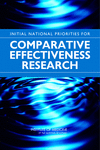Comparative effectiveness research (CER) identifies what works best for whom under what circumstances. Congress, in the American Recovery and Reinvestment Act (ARRA) of 2009, tasked the Institute of Medicine (IOM) to recommend national priorities for research questions to be addressed by 
funding using broad stakeholder input, and identifies the necessary requirements to support a robust and sustainable CER enterprise. The full list of priorities and recommendations can be found online and include many preventive measures:
Compare the effectiveness of primary prevention methods, such as exercise and balance training, versus clinical treatments in preventing falls in older adults at varying degrees of risk.
Compare the effectiveness of school-based interventions involving meal programs, vending machines, and physical education, at different levels of intensity, in preventing and treating overweight and obesity in children and adolescents.
Compare the effectiveness of interventions (e.g., community-based multi-level interventions, simple health education, usual care) to reduce health disparities in cardiovascular disease, diabetes, cancer, musculoskeletal diseases, and birth outcomes.